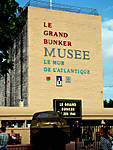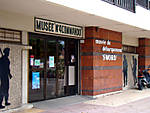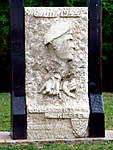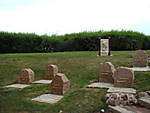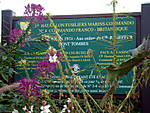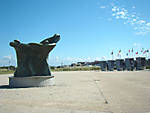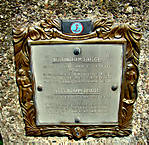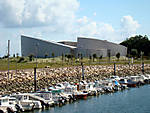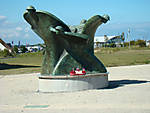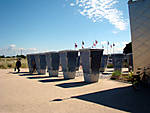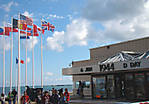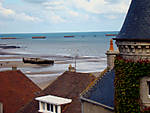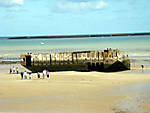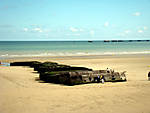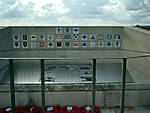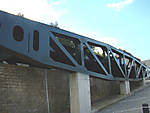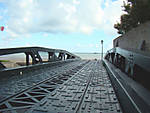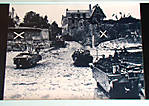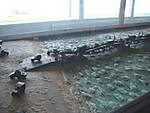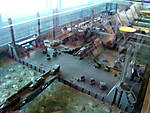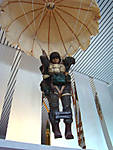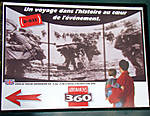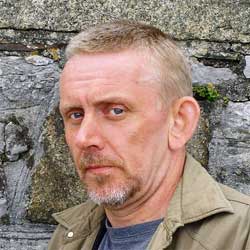1⁄1Postcard from Normandy
11
Comments
Dedication
This feature is respectfully dedicated to the memory of the countless thousands of Soldiers, Sailors and Airmen who participated in the preparation and execution of the greatest amphibious assault in history, the landings in Normandy which began on the 5th/6th of June 1944. It's also dedicated to the many thousands of exiles from France, Belgium, Norway, Czechoslovakia, Poland and Holland who, after more than four years in waiting, were able to play an important part in the liberation of Europe. It's also dedicated to those extraordinary men and women in the various resistance movements who did NOT capitulate - the price they paid is often to be seen on war memorials in village squares or churchyards across France or the rest of the occupied territories. My thoughts also go to the various veterans of the conflict and to the governments who have ensured that there are lasting monuments to those terrible and magnificent days which began in June 1944.About this feature
My wife and I spent 10 days on vacation in Normandy this summer. This feature is not designed as a definitive guide to the sites of interest in the region, but rather as a personal view of a journey which anyone interested in Military History should attempt to make. There's a lot to see and a lot of stunning landscapes to enjoy - it's also a great place for eating and drinking! I'll be breaking down the feature (broadly) into the beaches and taking side-trips into areas which particularly interested me. We based ourselves in Caen which, due to its size and proximity to the landing beaches seemed to be the best option - the other (Bayeux) is considerably smaller although nearer to the beaches of UTAH, OMAHA and GOLD. We visited four of the beaches - leaving out UTAH due to time limitations.From Caen to Ouistreham - Sword Beach
Ouistreham is a small seaside resort with a good harbor and is built on the mouth of the Orne estuary. Here begins the first of the D-Day landing beaches - Sword, where many of the most spectacular commando actions took place. In Ouistreham there are two very interesting museums - Musée Nº 4 Commando and the massive German artillery Command bunker which has been converted into Musée du Mur de l'Atalantique (Museum of the Atlantic Wall). The first, which is housed on the ground floor of a modern apartment block, covers the story of the French Nº 4 Commando and is a small but very interesting museum whose centrepiece is an excellent documentary dealing with the formation and action of this small (177 personnel) but extraordinarily brave unit of French exiles. The 'Gran Bunker' is an extraordinarily interesting museum which serves to recreate what life was like inside a bunker of this type - areas such as the medical center and the generator room have been convincingly recreated. It also contains an huge collection of German weaponry and equipment. The only negative note are the vehicles parked outside which are painted in some of the most bizarre color-schemes imaginable. The town of Ouistreham itself is pleasant enough but has been redeveloped and is dominated by the modern Ferryport (behind which there are a couple of interesting bunkers). The site of the original Casino (one of the objectives for Nº4 Commando) has a modern Casino on the same spot, which looks as if it was rejected on aesthetic grounds, by the town planners of Las Vegas...Ouistreham to Courselles-Sur-Mer - Juno Beach
JUNO beach was the Canadian sector of Operation Overlord. The beach area can be accessed through the town itself. Of the four beaches we visited, this is perhaps the most evocative of all. The centerpiece is the visitor center (the only one covering the Canadian landings) which is designed in the form of a Maple leaf. Outside the center, there are a number of metal momoliths which carry the names of the Canadian casualties according to regiments. Poignantly, one of the first group of names I found listed a number of Canadian troops murdered by 12th SS PD. Even 60+ years on, JUNO is a very atmospheric area - not exactly gloomy but certainly a little overcast.. Courselles-Sur-Mer is a small seaside resort which, in part at least, has seen better days. The seaward end of the harbor is dominated by a large (and pretty tasteless) monument commemorating the landing of General DeGaulle in august 1944. What is interesting in the center is the DD Sherman which has the regimental badges of the participating Canadian Regiments welded onto its hull.Bayeux to Arromanches - Gold Beach
Bayeux is the logical place to travel from to reach Arromanches - the neuralgic point for GOLD beach. Here, was one of the most spectacular additions to the post D-Day topography, the artificial harbors which were code-named Mulberry. As one enters the town, the bay opens up in front of you and you see a huge dotted semi-circle around the bay. These are the concrete caissons which the roadways and harbor areas were laid onto and apart from a preserved section of roadway, that is all that's left of one of the most spectacular engineering achievements in history. The other (iron) caissons are still in a line towards the beach and are embedded in the sand, quietly rusting away... Overlooking the beach and the bay, is the visitor center/museum. This contains many similar items/relics which can be found in the other visitor centers apart from one significant item. As a center point to the visit, a HUGE diorama has been built of a section of a Mulberry (1/35th scale) which includes the cargo ships offloading onto the Quay sections and the vehicles making their way across the road sections. The sea section has a type of 'diaphragm' which simulates the movement of the sea - with the road sections remaining horizontal, exactly as the original did. Another item in the museum is one of the items most responsible for our misconceptions of the Normandy landings - a 'Rupert'. On the night of the 5th of June, the Allied Airforces dropped hundreds of dummy paratroopers on areas they weren't dropping actual troops. This is one of the models used in the movie, 'The Longest Day' - the actual 'Ruperts' were simply basic figures made from sacking, almost like small scarecrows... The town center, unlike the other towns on the 'Trail' is pretty 'tacky' with the central square being surrounded by souvenir shops selling a variety of tasteless items.. Leaving the town and following the road up to the cliffs overlooking the bay, a great vista opens up - once again showing the enormous scale of the Mulberry project. Up on the cliffs is Arromanches 360 - a movie theater which shows a 360º film of the landings. Due to the huge queues, we decided to give it a miss. From the cliffs looking down (and up the coast, this is the point where one really gets an idea of what an incredible undertaking Overlord acually was - to the left the beaches of Omaha, to the right, the beaches of Juno and Sword - best free show in town!Comments
Great article. Im not an armour modeller but my uncle was in 7 para who fought at Pegasus Bridge so I've got a specific interest in this part of WW11. I've been lucky enough to visit Normandy twice and can back Jim up that the Pegasus Memorial Museum was by far the best I visited. If you’re going to visit Benouville I recommend visiting the Commonwealth War Cemetery at Ranville. This is a relatively small but beautifully looked after cemetery that is the resting place for most of the casualty’s of 6th Airborne and the commandoes. (It also has a number of German graves). Not only does it contain the grave of Lt Den Botheridge who was the first allied casualty of the war (he died in the attack on Pegasus Bridge) but also my uncle.
One point on Jims text though, and I don’t want to sound picky here but the Ox’s and Bucks were relieved not by the commandoes (who actually just passed through the paras) but were relieved by 7 Para at around 2.30 in the morning. The role of 7 Para is often forgotten completely or at best lightly touched (see Stephen Ambrose’s Pegasus Bridge) but most of the fighting to protect the bridge was undertaken by them. They fought off concerted attacks by the Germans who attacked in company strength backed by tanks and self propelled guns. Having lost their heavy mgs in the drop 7 Para (who could only muster half their strength at this point) fought off these attacks with nothing more than small arms and gammon bombs. At one point the battalion aid post was overrun and the wounded and Chaplin killed.
On one of my visits I was luck to be able to speak to Arlette Gondree who now runs the cafe at Benoville. She was very passionate about the role that 7 Para played in the battle and felt that their contribution had been long overlooked, in fact she went as far as to say that if weren’t for the paras the village would have been overrun and the villages "killed in their beds". Her words not mine.
Sorry about the length of the post but Imp proud of my uncle who was killed at 19 having given up a reserved occupation to fight.
SEP 06, 2008 - 08:16 AM
Jason, thanks for that post. No, you're correct. 7 Para are pretty much missing from any 'official' report on the action at Benouville. Unfortunately, that night, there was a lot of confusion and I think that Lovatt was given the credit (though not asking for it) - what your comments suggest is taht there should be another look at the 'official' histories..
I was 'taught' the operation while in the Terriers (T.A./ National Guard) and, I make no bones about it, I still consider it one of the greatest acheivements of Airborne Troops ever. I've been to Pegasus 4-5 times and every time I have to pause and think at just what an extraordinary operation was acheived that night. Even now, 60+ years afterwards, there's still an 'air' about the place...
SEP 06, 2008 - 12:38 PM
Great & informative article Jim.
Thank-you.
I'll be going to Normandy next June.
Paul
SEP 06, 2008 - 01:00 PM
Great article Jim ... one of the best for a long time. Its a refreshing change of pace from new kits and niggling over small details. I enjoyed looking through the pics and seeing these places of how it is today. Have never been there myself, but this article really makes me want to go. Hopefully some day!
SEP 06, 2008 - 01:43 PM
Very well done article Jim .
This article will be part of my guide for the trip o/seas for next year to slot inbetween Euro Miltaire.
The photo's taken by your wife certainly captures a serenity and moment to reflect of such a, how can I can I say ,world saving cause .
To be a related to a person who fought or served in this theatre should be very proud of their family achievements for what they have done .
SEP 06, 2008 - 04:43 PM
Here's the link for an abbreviated Unit history of 7th Parachute Battalion (part of 5th Para Brigade);
http://www.pegasusarchive.org/normandy/unit_5parabgd.htm
SEP 06, 2008 - 09:05 PM
Jim
Thanks for the comments. I can fully recommend the Pegasus archive website, it’s a great resource for anyone interested in the part of 6 airborne division in Normandy. Jim, I certainly think that the public perception of the battle for Pegasus bridge needs to be changed. When I first visited Benouville all I knew about battle came more or less from the Stephen Ambrose Book, Pegasus Bridge. However, following that conversation with Arlette Gondree, where she was quite forthright in her support of 7 Para I became interested in uncovering more on their role. I bought a small book in the museum called a Tale of Two Bridges which is the story of 7 para’s role in Normandy based on the diary of Col Pine-Coffin, the commander of 7 para along with contributions from other member of battalion published by Col Pine-Coffins son. I got in touch with the Pine-Coffin family, and thanks to his grandson, who is planning to publish a second book on the battalion I was able to find out more about my uncles time in the battalion. I also visited the records of the National Army Museum, the Airborne Museum at Aldershot and the National records office in Kew.
All that research showed that there was much more to the battle than presented in the Ambrose book. He doesn’t get things wrong more in concentrating almost exclusively on the glider troops has left out the contributions of the other units involved (and not just 7 Para). The book also suffers form being based primarily on the recollections of certain individuals who took part. However Ambrose did not allow those who contributed to view his manuscript before publishing and this lead in his own words to mistakes. He acknowledges this in the text of Band of Brother.
Once 7 para had arrived at the Bridges they became responsible for the defence and the Ox and Buck became attached to them, Major Howard passing over control to Pine-Coffin. He placed the glider troops in reserve in between the two bridges. The eastern end of the bridges, the river bridge was actually defended by a company of 12 Para. From then on the vast majority of fighting for the bridge was undertaken by 7 Para. That fighting would go on almost all and well beyond the arrival of the Commandoes. 7 Para would lose 70 men killed that day opposed to 3 by the initial glider coup-de-main, two of which were killed in the initial landing.
I was unaware that the planning of invasion assumed that the glider attack would fail and that the bridges would be blown. Both the Ox and Bucks and 7 para took folding boats with them and a platoon of the Para’s were specifically trained to use the boats to ferry troops across the river and canal. The 2nd Battalion the Warwickshire Regiment who were the actual troops to relieve 7 Para had been told that the bridge would be blown and to expect to have to fight for control of the western bank of the canal. Furthermore, the actual first troops to reach the bridges were not the Commandoes but there is evidence that it was a recce troop of engineers who were tasked to build a bailey bridge to replace the expected blown one (They are said to have arrived in a jeep and white scout car). This was actually built as the original bridge is narrow and wouldn’t have been able to cope with expected traffic across it.
There’s also evidence that a troop of sherman’s got into Benouville and disappeared along the Caen Road never to be seen again. You armour modellers might be interested to know that the “tank” described has having been knocked out by PIAT early on in the battle was probably a half track. This is described as having a small gun so may have been a 251 with a 37mm doorknocker. This seems reasonable as there was a german engineer unit in the area and would explain both the ease with which it was knocked out by the PIAT and why the remaining vehicles retreated so quickly. The armoured vehicles that were used in the attack on Benouville seems to have comprised a mix of Panzer 1V’s, Marders and what are described as French tanks, which I assume were Renaults.
Anway I could on like this for hours so will pack it in now. Please everybody if you’ve got some time read the 7 para history on the link that Jim sent or if your realy interested get hold of A tale of two bridges.
SEP 07, 2008 - 12:39 AM
Nice article Jim.
Myself and four Belgian friends (I am a Brit ex squaddie BTW) went to Normandy last year for 9 days (St M E to Caen), we had a great time. Very moving too, we also passed Arras on the way where my Great Grandfather is comemorated on the WWI memorial.
We did Ypres this year and its off to The Ardennes next year (we are doing that in Dec so we can fuffer some of the conditions those poor guys had to endure). I have a lot of pics and vids of Normandy (and Ypres and lots from wtaerloo) if anyone needs extra material.
Cheers
Sid
SEP 08, 2008 - 09:13 AM
Copyright ©2021 by Jim Rae. Images and/or videos also by copyright holder unless otherwise noted. The views and opinions expressed herein are solely the views and opinions of the authors and/or contributors to this Web site and do not necessarily represent the views and/or opinions of Armorama, KitMaker Network, or Silver Star Enterrpises. All rights reserved. Originally published on: 2008-09-22 00:00:00. Unique Reads: 18662







